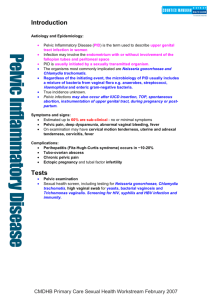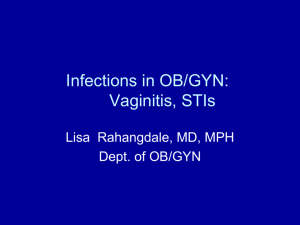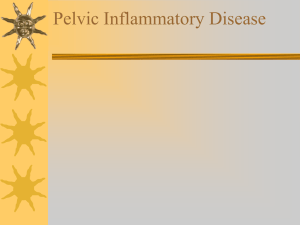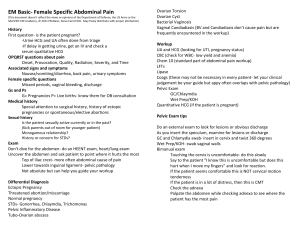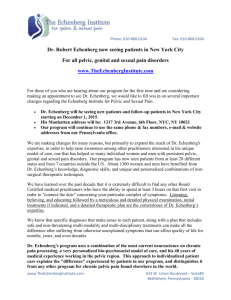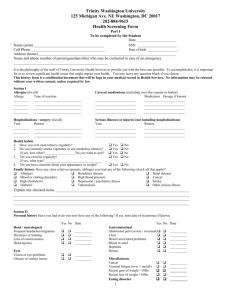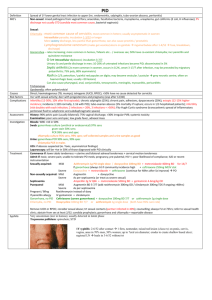HERE
advertisement
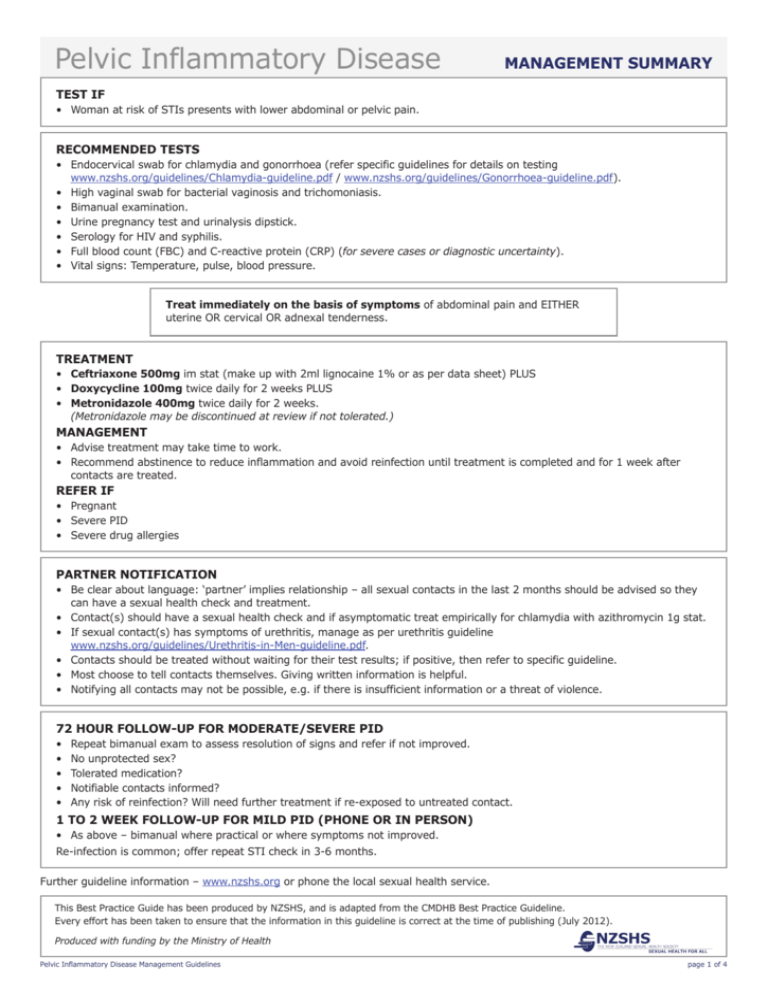
Pelvic Inflammatory Disease MANAGEMENT SUMMARY TEST IF • Woman at risk of STIs presents with lower abdominal or pelvic pain. RECOMMENDED TESTS • Endocervical swab for chlamydia and gonorrhoea (refer specific guidelines for details on testing www.nzshs.org/guidelines/Chlamydia-guideline.pdf / www.nzshs.org/guidelines/Gonorrhoea-guideline.pdf). • High vaginal swab for bacterial vaginosis and trichomoniasis. • Bimanual examination. • Urine pregnancy test and urinalysis dipstick. • Serology for HIV and syphilis. • Full blood count (FBC) and C-reactive protein (CRP) (for severe cases or diagnostic uncertainty). • Vital signs: Temperature, pulse, blood pressure. Treat immediately on the basis of symptoms of abdominal pain and EITHER uterine OR cervical OR adnexal tenderness. TREATMENT • Ceftriaxone 500mg im stat (make up with 2ml lignocaine 1% or as per data sheet) PLUS • Doxycycline 100mg twice daily for 2 weeks PLUS • Metronidazole 400mg twice daily for 2 weeks. (Metronidazole may be discontinued at review if not tolerated.) MANAGEMENT • Advise treatment may take time to work. • Recommend abstinence to reduce inflammation and avoid reinfection until treatment is completed and for 1 week after contacts are treated. REFER IF • Pregnant • Severe PID • Severe drug allergies PARTNER NOTIFICATION • Be clear about language: ‘partner’ implies relationship – all sexual contacts in the last 2 months should be advised so they can have a sexual health check and treatment. • Contact(s) should have a sexual health check and if asymptomatic treat empirically for chlamydia with azithromycin 1g stat. • If sexual contact(s) has symptoms of urethritis, manage as per urethritis guideline www.nzshs.org/guidelines/Urethritis-in-Men-guideline.pdf. • Contacts should be treated without waiting for their test results; if positive, then refer to specific guideline. • Most choose to tell contacts themselves. Giving written information is helpful. • Notifying all contacts may not be possible, e.g. if there is insufficient information or a threat of violence. 72 HOUR FOLLOW-UP FOR MODERATE/SEVERE PID • • • • • Repeat bimanual exam to assess resolution of signs and refer if not improved. No unprotected sex? Tolerated medication? Notifiable contacts informed? Any risk of reinfection? Will need further treatment if re-exposed to untreated contact. 1 TO 2 WEEK FOLLOW-UP FOR MILD PID (PHONE OR IN PERSON) • As above – bimanual where practical or where symptoms not improved. Re-infection is common; offer repeat STI check in 3-6 months. Further guideline information – www.nzshs.org or phone the local sexual health service. This Best Practice Guide has been produced by NZSHS, and is adapted from the CMDHB Best Practice Guideline. Every effort has been taken to ensure that the information in this guideline is correct at the time of publishing (July 2012). Produced with funding by the Ministry of Health Pelvic Inflammatory Disease Management Guidelines page 1 of 4 Pelvic Inflammatory Disease MANAGEMENT GUIDELINES Introduction • • • • • Pelvic inflammatory disease (PID) is the term used to describe upper genital tract infection in women. Infection may involve the endometrium, with or without involving the fallopian tubes and peritoneal space. PID is usually a sexually transmitted condition. The organisms most commonly implicated are Chlamydia trachomatis, Neisseria gonorrhoeae, mycoplasmas and mixed anaerobes. True incidence is unknown due to non-specificity of lack of symptoms. Risk factors • • • • Age < 25. Recent change in sexual partner. Multiple partners. Previous STI. In addition to sexual transmission, PID may follow: • • • • Intrauterine device (IUD) insertion. Termination of pregnancy. Post partum states. Upper genital tract instrumentation. Symptoms and signs • Estimated up to 60% sub-clinical – that is may have no or minimal symptoms. • May present with lower abdominal pain, deep dyspareunia, abnormal vaginal bleeding or discharge. • On examination may have cervical motion tenderness, uterine and/or adnexal tenderness, cervicitis or fever. Complications • • • • Tubo-ovarian abscess. Chronic pelvic pain. Ectopic pregnancy and tubal factor infertility. Perihepatitis (Fitz-Hugh Curtis syndrome) occurs rarely. Diagnosis • Diagnosis is clinical, taking into account the history, clinical findings and supplemental tests. • No single laboratory test is diagnostic of PID and STI tests will often be negative. • A low threshold for treatment is appropriate in view of important sequelae and diagnostic uncertainty. Initiate PID treatment for the following criteria • Pelvic pain AND • Uterine tenderness OR adnexal tenderness OR cervical motion tenderness. Additional supportive features • • • • Abnormal cervical or vaginal mucopurulent discharge. Fever >38°C. Elevated white blood cell (WBC) or CRP. Confirmed infection with an STI or bacterial vaginosis. Differential diagnoses The main differential diagnoses to consider are: • Pregnancy complications, e.g. ectopic, spontaneous abortion. • Appendicitis. Pelvic Inflammatory Disease Management Guidelines page 2 of 4 Diagnostic tests (refer to chlamydia or gonorrhoea guideline www.nzshs.org/guidelines/Chlamydia-guideline.pdf / www.nzshs.org/guidelines/Gonorrhoea-guideline.pdf) All women with suspected PID should have a full evaluation for STIs including: • • • • • • Endocervical swab/s for chlamydia and gonorrhoea testing. A high vaginal swab for bacterial vaginosis and trichomoniasis. Bimanual pelvic examination to assess for tenderness and pelvic masses. Urine pregnancy test to exclude ectopic pregnancy. Consider FBC and CRP, urine dipstick. Serology for hepatitis B, syphilis and HIV is recommended. Management • • • • Assess for PID severity (mild, moderate or severe). Treatment should cover for infection with gonorrhoea, chlamydia and anaerobes. Patients with severe infection, pregnancy or a suspected tubo-ovarian abscess require gynaecology referral. Contact sexual health services for advice in breastfeeding. Treatment regimens Mild/moderate PID Few regimens provide >90% efficacy. • Ceftriaxone 500mg im stat (make up with 2ml lignocaine 1% or as per data sheet) PLUS • Doxycycline 100mg twice daily for 14 days PLUS • Metronidazole 400mg twice daily for 14 days. Note: • Metronidazole may be discontinued if not tolerated. • The regimen may be used for mild penicillin allergy. • Contraindications to administration of ceftriaxone are cephalosporin allergy or previous severe penicillin allergy such as anaphylaxis. • Discuss with specialist if unsure. Concerns about poor compliance • Ceftriaxone 500mg im stat (make up with 2ml lignocaine 1% or as per data sheet) PLUS • Azithromycin 1g on day 1 and day 8. Note: • There is insufficient data on long term efficacy to recommend for first line use. • The regimen may be used where there are concerns regarding ability to abstain from alcohol during treatment. IUD users • Evidence suggests PID treatment is not hindered by the presence of an IUD. • The decision as to whether or not an IUD should be left in situ should be made on a case by case basis in consultation with the patient. • If the IUD is removed, recommend delaying this until approx 24 hours into antibiotic therapy and consider ECP. • If there is inadequate clinical response at review, IUD removal should be considered. Partner notification and management of sexual partners Partner notification • Be clear about language: ‘partner’ implies relationship – all sexual contacts in the last 2 months should be advised so they can have a sexual health check and treatment. • Contacts should be treated without waiting for their test results; if positive, then their recent contacts need to be informed. • Most choose to tell contacts themselves. • Giving written information is helpful. • Notifying all contacts may not be possible, e.g. if there insufficient information or a threat of violence. Management of sexual partners/contacts • • • • Perform a full sexual health check Do not wait for test results – treat empirically with azithromycin 1g stat. – If gonococcal infection is suspected then add ceftriaxone 500mg im stat. Advise them to use condoms or abstain from sex for 7 days until results of tests are available. If chlamydia or gonorrhoea positive – partner notification as above. Pelvic Inflammatory Disease Management Guidelines page 3 of 4 Follow-up • In mild PID, patients should be reviewed in 1 week and pelvic examination repeated to confirm resolution of signs and review results. • In moderate PID, patients should be reviewed in 48-72 hours and if not improving consider gynaecology referral. • Repeat a sexual health check 3 months after treatment. Referral guidelines Referral to a specialist sexual health service is recommended for: • Management of sexual partners if clinician wishes. • Recurrent/persistent PID. Further guideline information – www.nzshs.org or phone the local sexual health service. This Best Practice Guide has been produced by NZSHS, and is adapted from the CMDHB Best Practice Guideline. Every effort has been taken to ensure that the information in this guideline is correct at the time of publishing (July 2012). Produced with funding by the Ministry of Health Pelvic Inflammatory Disease Management Guidelines page 4 of 4
